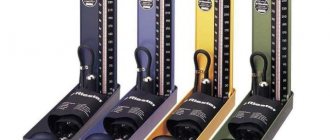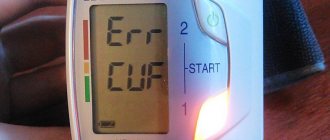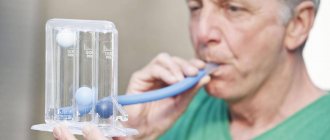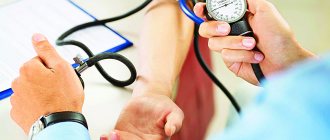In order for the tonometer to show an accurate blood pressure value, the measurement must be carried out correctly. With automatic devices (read the article about the types of tonometers), everything is relatively simple: just put a cuff on your shoulder or wrist, turn on the device, and then it will do all the work itself.
In this article you will find detailed step-by-step instructions for using mechanical and semi-automatic blood pressure monitors.
At home, you can ask someone in your family to measure your blood pressure, or do it yourself. It is better to take the measurement on your left hand - it will be more convenient for you to hold the bulb and pump air with your right hand.
What is a tonometer for?
The main purpose of the tonometer is to measure and control blood pressure, a systematic increase in which can be a sign of a wide variety of diseases. Perhaps the most serious and widespread of them is hypertension, or as the disease is popularly called the “silent killer.” The main danger of the disease is that it may not manifest itself for years, and then suddenly lead to vascular disasters: angina pectoris, stroke, myocardial infarction, heart and kidney failure.
Hypertension is called the “silent killer” due to its long absence of symptoms.
Despite the apparent simplicity of the tonometer design, independent use of the device requires compliance with some recommendations and requirements. Only its correct use can guarantee the user the provision of accurate information about the state of his health.
Best models
What is the best semi-automatic blood pressure monitor from a users' point of view? This is an accurate and simple device. Accuracy is necessary to obtain reliable data on which you can take medications, see a doctor, etc. Ease of operation is also important for buyers, because if the device is complex, then a person far from medicine will have difficulty measuring pressure.
“A good tonometer is an expensive tonometer.” This is exactly the opinion that exists among some buyers. But this is not always justified. After all, most often the buyer overpays money not so much for quality, but for the brand. That is why it is very important to understand the companies of tonometers and determine the most optimal option, both in terms of quality and price.
To choose the optimal model for yourself, consider the rating of the best semi-automatic blood pressure monitors of 2021.
AND UA-604
pros
- The battery lasts a long time (only one battery is enough for operation, which provides more than 2000 measurements), and the tonometer is easy to use.
- Compact device, convenient, easy to inflate.
- In addition to pressure, it also shows pulse rate.
- There is a self-shut-off function.
- 2 memory cells, saving data even without power.
- Sound indicator, as well as time and date indication
Minuses
- Some measurement errors when the battery is low.
From 1220 ₽
This brand of semi-automatic blood pressure monitors has proven itself on the positive side for many years. As for the accuracy of the readings, user opinions differ here. Some praise the AND UA-604 for its extremely accurate measurement results, while others, on the contrary, are upset due to some errors. It is possible that such inaccuracies occur when the battery charge is low.
In general, the semi-automatic machine from AND UA-604 is ideal for everyday home use. The price-quality ratio is completely justified.
B.Well PRO-30 (M)
pros
- Autonomous power supply.
- Pulse measurement.
- Arrhythmia indicator.
- Maximum measurement accuracy
Minuses
- The cuff is medium in size and may not suit every customer.
From 830 ₽
If you are looking for an inexpensive and practical semi-automatic blood pressure monitor, then B.Well PRO-30 (M) is at your service. Convenient design and compactness will give you pleasure during use. By choosing B.Well PRO-30 (M), you choose quality and reliability. Many experienced users of the B. Well PRO-30 (M) tonometer are delighted with this device. It is called the “budget option”.
Omron M1 Compact
pros
- 30 memory cells.
- Fan-shaped cuff that follows the shape of the hand, as well as the ability to use both a large cuff and a children's set.
- The weight of the tonometer is only 256 grams.
- The ability to find the average pressure readings from three measurements taken over the last 10 minutes.
- Energy-saving technology (about 1500 measurements on one battery).
- Convenient case for storing the tonometer.
Minuses
- Not identified.
From 1400 ₽
There is an opinion that measuring pressure semi-automatically is doubly pleasant with the Omron M1 Compact tonometer. Choose a tonometer from this company, and you will not regret your choice.
Omron S1
pros
- Autonomous power supply.
- 14 memory cells.
- Sound indication and ability to save data without power.
- High blood pressure indicator – these are the parameters that will definitely appeal to a wide range of buyers.
- Affordable price.
- Ease of use and measurement accuracy.
Minuses
- No arrhythmia indicator
- Uncomfortable cuff.
From 1600 ₽
The semi-automatic tonometer for measuring blood pressure from Omron S1 has won recognition from both ordinary users and medical professionals. Omron S1 tonometers are rightfully recognized as one of the best tonometers in their category.
Factors influencing the measurement result
In addition to proper use of the tonometer, the result of taking blood pressure readings can also be affected by factors such as:
- age (in young people, normal blood pressure is considered to be 120/80 mm Hg with a permissible deviation of 10 mm Hg);
- gender (according to the observations of specialists, in women the blood pressure differs by 5-10 mm Hg from the blood pressure values of men);
- time of day (in the evening, blood pressure usually increases slightly);
- consumption of certain foods (caffeine, fried, salty, sweet and fatty foods are known to increase blood pressure);
- state of physical activity before measurement (after walking, playing sports, blood pressure increases, and at rest it returns to normal);
- the presence of bad habits (smoking and drinking even a small amount of alcohol provoke an increase in blood pressure).
To obtain the most accurate results, before using the tonometer, it is recommended to refrain from smoking, drinking strong tea and coffee, and taking medications that affect the cardiovascular system.
Blood pressure readings should not be taken immediately after drinking coffee and tea.
Advantages and disadvantages of semi-automatic machines
Semi-automatic blood pressure monitors have their positive and negative sides. They should be taken into account when choosing a device.
Advantages of a semi-automatic machine:
- Blood pressure measurement accuracy.
- Ability to save test results.
- Low price compared to automatic devices.
- Long service life.
- Availability of additional functions.
- Lower error.
One of the disadvantages is that it is powered by removable batteries. Users have to stock up on them. When the batteries are running low, the device may provide inaccurate BP readings.
To power the tonometer, 4 AA batteries are most often used.
Which hand is the correct one to measure blood pressure on?
Blood pressure is measured in the upper forearm. You can use any hand, but keep in mind that the readings will be slightly different.
It is believed that right-handers have higher blood pressure on the left hand, and left-handers have higher pressure on the right, so it is recommended that right-handers take blood pressure readings from the left hand, and left-handers from the right.
In order to select one arm on which blood pressure readings will be taken continuously in the future, it is necessary to take measurements on both limbs 10 times with an interval of 5 minutes (to restore blood circulation). The difference in the values obtained from measurements on different hands is explained by the anatomical feature of the structure of the cardiovascular system of each individual person.
How to use a mechanical and electronic blood pressure monitor
Modern manufacturers of medical equipment market electronic and mechanical blood pressure monitors that perform the same function, but differ from each other in design and method of determining blood pressure.
Regardless of the device chosen, before taking measurements, it is necessary to put on the tonometer cuff so that it is located 2-2.5 cm above the elbow joint. There must be free space between the cuff and the forearm, into which an adult’s finger can easily fit. Lying down during measurement is not recommended; to obtain the most accurate results, it is better to sit the person in a comfortable chair or on a chair.
It is recommended to check blood pressure in a calm state, in silence, with a straight back and an empty bladder. It is prohibited to measure blood pressure while intoxicated or during periods of excitement or stress.
Mechanical tonometer
To measure blood pressure with a manual device you must:
- take a comfortable position;
- put the device cuff on your arm;
- place the dial at eye level;
- place the phonendoscope on the brachial artery (bend of the elbow), feel the pulsation;
- Screw the wheel tightly on the side of the pear;
- pump air into the cuff until the arrow reaches 210 mmHg. Art.;
- release the bulb, open the valve slightly;
- carefully watching the air come out, wait for the peculiar beats and fix the dial mark on the first (upper systolic pressure) and last audible sound (lower diastolic pressure);
- record measurement results;
- After 3 minutes, measure the pressure on the second arm.
When using a mechanical tonometer, control and constant monitoring of the device is important.
Electronic tonometer
An electric tonometer, unlike a mechanical device, takes measurements automatically, so measuring pressure with its help will not be difficult even for a person far from modern technology.
Correct use of an electrical device includes:
- placement of the cuff on the arm;
- placing the hand at heart level;
- waiting for measurement results on the screen;
- repeat the study to determine the average value after 5 minutes.
Wrist blood pressure monitor
The most convenient for older people is a wrist tonometer, which is a compact device for independently determining blood pressure. Of all the existing models of such devices, the Japanese hand tonometer “Omron” is especially popular, equipped with a liquid crystal display and a reliable cuff, characterized by compact dimensions, a significant amount of memory and the ability to operate on batteries or a rechargeable battery. Some variations of the omron wrist meter allow you to find out data on the heart rate due to the built-in arrhythmia indicator.
Device and principle of operation
To measure blood pressure with a tonometer, a special cuff is placed on the patient's shoulder. In semi-automatic models, fluctuations in air pressure in this cuff are recorded. This pressure is created under the influence of blood flow in the area of the artery that is pinched by the cuff.
Semi-automatic models of tonometers imply the absence of a compressor; air must be pumped manually using a bulb. The principle of operation in semi-automatic tonometers is oscillometric. As soon as the required pressure is reached, the tonometer automatically releases air.
Some time after processing the received data by the built-in microprocessor of the tonometer, the result of measuring systolic (when blood passes through a compressed artery) and diastolic pressure (when blood flows freely through the artery) appears on the device screen.
Errors when using a tonometer
Most often, inaccuracies in measuring blood pressure using a tonometer may result from improper use of the device or inattention on the part of the person himself.
- When placing the hand below the chest level, the blood pressure value may be less than the actual value.
- If the person is not leaning on the back of a chair during measurement, pressure readings may be higher due to muscle tension.
- If the cuff of the device is tightened too tightly, the results may deviate upward.
- If the cuff is worn over a clothing sleeve, blood pressure readings may be unreliable. Measurements should be taken only on your bare hand.
- If the cuff is poorly inflated with air, the device readings may be somewhat overestimated.
- Talking, watching TV and gesturing are not allowed while using the tonometer. Such actions certainly contribute to elevated blood pressure values.
- Taking blood pressure readings immediately after eating or physical activity is the reason for the measurement values being too high.
- It is incorrect to measure blood pressure without short breaks. Five-minute time intervals between readings are required.
It is better to select and buy tonometers in pharmacies or specialized stores that can provide documents confirming the originality, reliability and high quality of devices for measuring blood pressure.
What to look for when purchasing?
When purchasing, you should pay attention to the frequency of use of the tonometer and who will use it.
Before purchasing, it is better to consult a doctor. Individual and age characteristics, the nature of the disease, additional tasks assigned to the tonometer determine the choice of the type of device. To measure blood pressure, a pediatrician or cardiologist will select a model, taking into account the following parameters:
- type - automatic or semi-automatic;
- frequency of use;
- convenience of displaying measurement results;
- the patient’s ability to use the selected model;
- correct cuff size;
- need for additional options.
To determine the required size, measure the circumference of the arm in the place where it will be attached, between the elbow and shoulder. Most devices are equipped with a cuff size M. Large people should purchase a special cuff with a larger diameter. If the wrong size is selected, the results may be inaccurate. You can determine the cuff size from the size table:
| View | Girth, cm |
| Small - S (small) | 18—22 |
| Medium - M (medium) | 22—32 |
| Large - L (large) | 32—45 |











